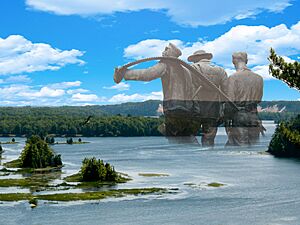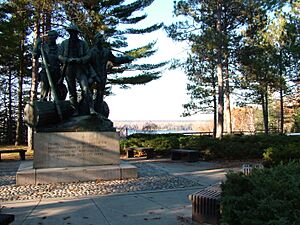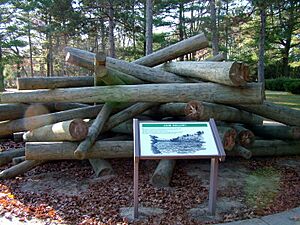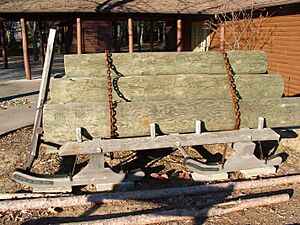Lumberman's Monument facts for kids
The Lumberman's Monument is a special statue in Oscoda Township, Michigan, USA. It honors the brave people who worked in Michigan's early logging industry. This big bronze statue, made by Robert Ingersoll Aitken, is about 14 feet (4.3 meters) tall. It shows a log with three important figures around it: a timber cruiser (who found the best trees), a sawyer (who cut them down), and a river rat (who helped move logs on the river). The statue's base has a message that says it was built to remember the first lumbermen of Michigan. Their hard work helped build many towns and farms in the Midwest. The monument also lists the names of logging families who worked in the area. It was built in 1931 and opened in 1932. The USDA Forest Service takes care of it. You can find the monument along the River Road Scenic Byway, a 22-mile (35 km) drive near the Au Sable River.
Contents
Exploring the Monument Area
The monument is located inside the eastern part of the Huron-Manistee National Forests. This is a large area of trees and nature. Nearby towns include Tawas City and East Tawas, about 11 miles (18 km) south. Au Sable and Oscoda are about 15 miles (24 km) to the east. Hale is about 11 miles (18 km) to the southwest. In the late 1800s, this area had many trees cut down for wood. This wood was used to build houses and factories across the country. After the logging slowed down, many new trees grew back. This is the forest you see there today.
What You Can Do at the Park
You can visit the Lumberman's Monument park all year round, and it's free! The visitor's center and other buildings are open from May to October. There are walking paths with signs that tell you about Michigan's logging history. The monument looks out over Cooke Dam Pond and Horseshoe Island on the Au Sable River. This river was very important for moving logs in the past.
Michigan's Logging Story
The forest around the monument was a very busy place for logging in the late 1800s. The white pine trees that grew here were in high demand. People needed wood for houses, ships, and other things all over the country. A lot of the homes in the Midwest were built with wood from Michigan.
When people realized how many trees Michigan had, logging became very popular and profitable.
- Timber cruisers worked for lumbermen. They would explore the forests to find the best trees. Then they would claim these areas for their bosses. Land could be bought for as little as $1.25 an acre back then.
- In the winter, sawyers cut down the trees. Swampers would trim the branches.
- The cut logs were then loaded onto big sleds. Horses or oxen pulled these sleds over icy paths to the nearest riverbank.
- The logs were dumped into the river and floated downstream to a sawmill.
- Workers downstream, sometimes called river rats, had to deal with log jams. These were huge piles of logs stuck together in the river.
- Once the logs reached the sawmill, they were cut into boards. These boards were then used to build houses and factories.
Michigan had many rivers and lakes, plus huge forests of pine and hardwood trees. This made it perfect for the lumber business. There were plenty of trees to cut, and lots of waterways to move the logs.
The lumber industry in Michigan grew a lot after the American Civil War. Cities like Detroit and Chicago were growing fast and needed a lot of wood. Logging reached its busiest time from the 1870s to the 1890s.
Logging also helped many towns grow, like Grayling, Manistee, Muskegon, and Alpena. But by the late 1800s, most of Michigan's old, big forests were gone. Thousands of acres were left as clear-cut land. Even though people started to understand the need to replant trees, it took a very long time for new trees to grow big. The decline of logging also led to many towns becoming "ghost towns," like Alcona and Killmaster (now Gustin Township, Michigan).
The Lumbermen Monument statue was created by Robert Ingersoll Aitken. If you look closely, you might see the words "Aitken Fecit" on it. "Fecit" is a Latin word meaning "made it," so it means "Aitken made it."
Gallery
See also
- Hartwick Pines State Park and Interlochen State Park, two places where you can still see very old Eastern White Pine trees in Michigan's Lower Peninsula.





